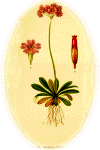


|
|
Annual Sea-Purslane A story of brinkmanship |
|
| I well recall that autumn day in 1987, when Simon Leach arrived back at the office after a day surveying and said he thought he had found Atriplex pedunculata in south Essex (well, he actually said Halimione pedunculata, in those dark days pre-Stace). Incomprehension gave way to disbelief as I recalled the story of its extinction in Britain in 1937 and the absence of any previous Essex records. Surveys of its former sites from Lincolnshire to Sussex were hurriedly organised, but drew a blank - we had the only British population hiding in a salt marsh backwater near Southend. Annual monitoring of the population
demonstrated its fluctuating nature - between 400 and 4000 plants - as
befits an annual species, causing us some concern that all our eggs were
in one rather small basket. So a local translocation, to a safe site behind
the MOD fence at Foulness, was in order - insurance against calamity. The
new population thrived initially until that fateful visit in 1993, when
we turned up to find an islander had unknowingly bulldozed the ‘safe’ site
to improve it for wildfowl. Still, we could rely on the native site.....until
we were greeted by a sward of rapidly-invading sea couch and a pitifully
small remnant population of Atriplex.
|
An on-site, executive decision - prepare a suitable seed bed by ripping out turves by hand, and move some seeds to their new home. We waited anxiously for the next year. Just in time - the original population indeed went extinct, and it survived only in our spur-of-the-moment translocation. A Species Recovery Plan was prepared urgently; plants and seeds were moved to further safe sites at Foulness, this time making sure the MOD and islanders were fully aware of its location. But it was not yet truly back from the brink - the risk of catastrophic sea wall failure was all too apparent. Spreading the risk is the best insurance:
seeds were lodged with Kew, others were grown in garden situations. Re-stocking
parts of its former range began, with variable success, and now plans are
well advanced for about five wild populations to greet the new Millennium.
But it remains a BAP Species of Conservation Concern, and one which owes
its survival more to luck than judgement. A better example of the need
for forethought and planning to guide projects under BAP is hard to imagine.
|
| Reproduced
from Biodiversity News with permission |
Dr
Chris Gibson Senior Conservation Officer English Nature, Colchester |